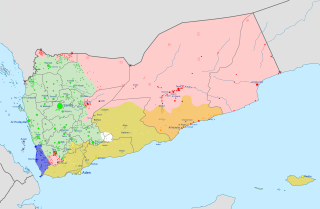
The Al-Qaeda insurgency in Yemen is an ongoing armed conflict between the Yemeni government, the United States and their allies, and al-Qaeda-affiliated groups in Yemen. It is a part of the Global War on Terror.

The following lists events that happened in 2015 in Yemen.

The Yemeni civil war is an ongoing multilateral civil war that began in late 2014 mainly between the Rashad al-Alimi-led Presidential Leadership Council and the Mahdi al-Mashat-led Supreme Political Council, along with their supporters and allies. Both claim to constitute the official government of Yemen.

On 26 March 2015, Saudi Arabia, leading a coalition of nine countries from West Asia and North Africa, launched a military intervention in Yemen at the request of Yemeni president Abdrabbuh Mansur Hadi, who had been ousted from the capital, Sanaa, in September 2014 by Houthi insurgents during the Yemeni Civil War. Efforts by the United Nations to facilitate a power sharing arrangement under a new transitional government collapsed, leading to escalating conflict between government forces, Houthi rebels, and other armed groups, which culminated in Hadi fleeing to Saudi Arabia shortly before it began military operations in the country.

The siege of Taiz is an ongoing, protracted military confrontation between opposing Yemeni forces in the city of Taiz for control of the city and surrounding area. The battle began one month after the start of the Yemeni Civil War.
On 24 July 2015, between 9:30 and 10:00 p.m., the city of Mokha, Yemen, was bombed by the Saudi Arabian led coalition. The airstrikes struck two worker housing complexes for engineers and technicians at the Mokha steam power plant. The attack left between 65 and 120 dead, including at least 10 children.

The Houthi–Saudi Arabian conflict is an ongoing armed conflict between the Royal Saudi Armed Forces and Iran-backed Yemeni Houthi forces that has been taking place in the Arabian Peninsula, including the southern Saudi regions of Asir, Jizan, and Najran, and northern Yemeni governorates of Saada, Al Jawf, and Hajjah, since the onset of the Saudi Arabian-led intervention in Yemen in 2015.
A Saudi Arabian-led military intervention in Yemen began in 2015, in an attempt to influence the outcome of the Yemeni Civil War. Saudi Arabia, spearheading a coalition of nine Arab states, began carrying out airstrikes in neighbouring Yemen and imposing an aerial and naval blockade on 26 March 2015, heralding a military intervention code-named Operation Decisive Storm. More than 130 health facilities(2019) in Yemen have been destroyed by a series of airstrikes conducted by the Saudi Arabian-led coalition since March 2015. Many of these have been public health hospitals staffed or supported by Doctors Without Borders (MSF). Critics of the assaults say the airstrikes are war crimes in violation of the protections of health care facilities afforded by the internationally recognized rules of war and have called for independent investigations.

Almigdad Mojalli was a Yemeni freelance journalist working for the United States media service Voice of America. On 17 January 2016 Mojalli was killed by a Saudi airstrike in a village near Sana'a while attempting to report on the Saudi Arabian-led intervention in Yemen.
The Battle of Port Midi refers to a battle during the Yemeni Civil War between the Saudi coalition-backed Hadi loyalists and the Houthi government. Although Hadi loyalists seized the port, the Houthi fighters along with the popular committees managed to conduct some attacks around Midi. The conflict also had spillovers in the rest of the Hajjah Governorate. On 26 January 2017, Hadi loyalists extended their control to Harad District in Hajjah Governorate.

War crimes and human rights violations, committed by all warring parties, have been widespread throughout the Yemeni civil war. This includes the two main groups involved in the ongoing conflict: forces loyal to the current Yemeni president, Abdrabbuh Mansur Hadi, and Houthis and other forces supporting Ali Abdullah Saleh, the former Yemeni president. Al-Qaeda in the Arabian Peninsula and the Islamic State of Iraq and the Levant have also carried out attacks in Yemen. The Saudi-led coalition, backed by the United States and other nations, has also been accused of violating human rights and breaking international law, especially in regards to airstrikes that repeatedly hit civilian targets.
The following lists events that will happen in 2016 in Yemen.
The following is a timeline of the Yemeni civil war, which began in September 2014.
Events in the year 2018 in Yemen.

On 22 April 2018, an airstrike by the Saudi Arabian-led coalition hit a wedding in the Bani Qa'is District of Hajjah Governorate, Yemen. Casualty estimates vary, with the Houthi-owned Al-Masirah reporting the toll later that day to be at least 33 civilians including the bride. Forty-five other people were injured.

The siege of Al Hudaydah, codenamed Operation Golden Victory, was a major Saudi-led coalition assault on the port city of Al Hudaydah in Yemen. It was spearheaded by the United Arab Emirates and Saudi Arabia and has been considered as the largest battle since the start of Saudi Arabian-led intervention in Yemen in 2015.
The Dhamar Airstrike took place on 1 September 2019 when Saudi led military coalition aircraft targeted a college building in Dhamar, Yemen that was used as a detention facility by the Houthis. According to the International Committee of the Red Cross (ICRC) in Yemen, the airstrike killed dozens of detainees.
During the Yemeni civil war, Saudi Arabia led an Arab coalition of nine nations from the Middle East and parts of Africa in response to calls from the internationally recognized pro-Saudi president of Yemen Abdrabbuh Mansur Hadi for military support after he was ousted by the Houthi movement due to economic and political grievances, and fled to Saudi Arabia.
On 21 January 2022, according to news sources a Saudi-led coalition carried out an airstrike on a prison in Saada, Yemen, killing at least 87 people. The coalition denied targeting the center.
The following is a timeline of the Yemeni humanitarian crisis, ongoing since the mid-2010s.






